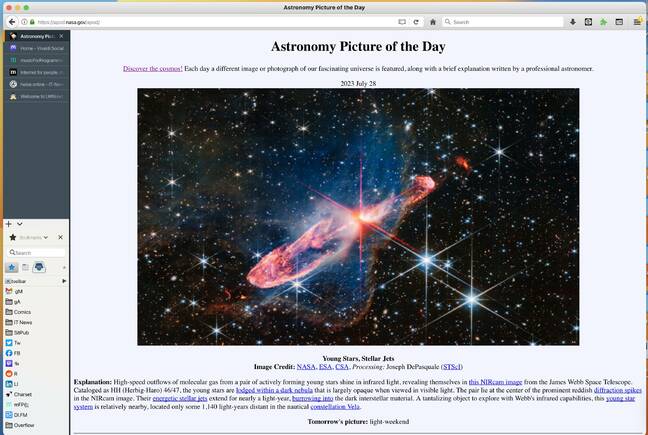The Zen Browser is a new effort to modernize web browsing by bringing tiling, workspaces, and so on – and it’s blissfully free of Google code.
Zen is a new web browser that’s still in the relatively early stages of development. Since we have been testing it, it’s gone from alpha 27 to 1.0.0-a.32, and during that time, it’s already noticeably improved in stability.
Zen lets you tile web pages inside a single window – here, for instance, showing The Register and all its sister sites in one – click to enlarge
The project reminds us strongly of Arc, a radical Chromium-based web browser that we looked at just over a year ago. Although we were impressed with Arc’s ambition, we found that we didn’t use it very much over the next few weeks – and now, we can’t. It’s still around, up to version 1.57, but we can’t try that because it requires macOS 13 or newer, and The Reg FOSS desk’s main desktop machine is a 27-inch Retina iMac that can’t officially run anything newer than macOS 12 “Monterey.” Arc, unhelpfully, doesn’t offer older versions for download; indeed, it doesn’t clearly specify its system requirements anywhere obvious. (If you dig into the company’s site, there is a single giant release notes page that mentioned this in passing last July.)
To recap, Arc is an effort to modernize the standard web browser user interface by revising some fundamental assumptions. It removes the URL bar from front and center, gets rid of the simple flat list of tabs, and so on.
Zen is trying to do some similar things, but in a slightly more moderate way – and it’s doing it on the basis of Mozilla’s Firefox codebase. That means it runs on some older OSes – it works fine on macOS 12.7.6, for instance – and it’s not quite so radical. For us, that is a good thing.

Zen has a dedicated side pane, with a pre-defined option to open Wikipedia. Handy for cross-referencing on the fly – click to enlarge
Being based on Firefox means that as well as running existing extensions, it can connect to Mozilla’s Sync service and pick up not just your bookmarks, but also your tabs from other instances, and so on. We found it easier to use than Arc, although it’s still a bit more complicated. As an example, while it’s easy to open a new page in a tab beside your current one, we found it trickier to work out how to tile existing tabs.
It also still has some of the Firefox features we’re familiar with, such as the combined-URL-and-search “awesome bar” as Mozilla used to call it. (Note, we didn’t say that we liked them, just that we’re used to them.)
Instead of the tired old horizontal tab bar you’ll see in both Firefox and Chrome, Zen implements its own tab bar. By default, it’s a vertical column down the left edge of its window (there’s an option to move this to the right, but it didn’t work for us). By default, this tab bar is narrow and just shows page icons – but there are some extra controls at the bottom of the sidebar, one of which expands the sidebar to show page titles too. For us, it worked better than Vivaldi’s fancier sidebar.
Also, handling this with a built-in native implementation has advantages over bundling an extension, as Reg FOSS desk favorite Firefox fork Waterfox does. For instance, if your existing Firefox profile in Mozilla’s cloud has a vertical tabs extension, you just get both tab bars. Two separate sidebars are easier to handle than two (or more) clashing sidebar extensions, one of which is tied into one specific variant.
The most visible new feature, though, is that Zen can tile web pages. Tiling inside an app will turn off some users, but bear with us. Tiles are like tabs. Arguably, you don’t need them if your OS already provides a visible UI for switching between browser windows. We’ve encountered users who don’t want and don’t use tabs, and prefer to manage separate instances. That is perfectly fine, if it fits your use case.

Another use of Zen’s tiles: Looking at source material while working on a response to it at the same time – click to enlarge
For us, though, we usually have many dozens of tabs open, and we don’t want that cluttering up the OS’s primary UI. We don’t want a taskbar or dock full of umpteen browser icons.
Much the same goes for tiling. Most modern OSes can support some kind of window tiling, especially Linux. Although this vulture rarely runs Windows and generally dislikes version 11, he actually quite likes the basic tiling feature in recent releases (especially compared to Microsoft’s clunky and nearly unusable virtual desktops). Pull a window toward a screen edge, and it will snap there, but in Windows 11, the OS then visually prompts you in case you’d like to tile the previous window you were using on the other side of the screen. It’s subtle but effective.
In a somewhat similar way, on macOS, the author uses Rectangle for keyboard-driven tiling, plus a few other tweaks such as AltTab – and MiddleClick on MacBooks.
The point is that if you’re a bit of a power user, you probably already have tools and methods to help you manage your windows, quickly place them side by side, and so forth. In your browser, you may well have some add-ons too, as we did in our old Waterfox Classic setup, with a vertical tab bar combined with a flattened bookmarks sidebar and so on.
If so, you probably don’t need Arc or Zen. If you have your own window manager tweaks and don’t need it – well, good for you. Tools such as Arc and Zen may be of only passing interest, and you can move on. But we suspect most web users don’t have advanced customizations like that. We don’t know for sure, but we would think that they don’t know how to tile windows… let alone more advanced tasks, like how to have separate profiles for home and work and flip between them, and so on.
Much of what little innovation that’s occurring in browsers has been on the basis of Chromium recently. Edge has vertical tabs and MS cloud integration; Vivaldi has a more powerful UI and an email client; Brave has ad-blocking and, er, integrated cryptocurrencies?

Vintage stuff: Just for comparison, this is Waterfox Classic, with a hand-crafted merged sidebar using three different XUL extensions – click to enlarge
Arc tries lots of new things, but it’s both hard to learn and it still keeps you in Google’s sphere. Zen is trying to do comparable things, in a gentler way, using the last truly FOSS cross-platform web browser standing. It could bring power-user sophistication to mere mortals. That’s good. It’s the sort of thing Mozilla ought to be doing, but isn’t. So we are glad someone is trying it. It’s very early days – it’s only an alpha – but it’s looking promising. ®

